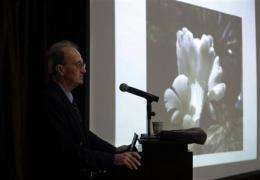Tiny mushrooms blamed for 400 deaths in SW China

(AP) -- Every year during the height of the rainy season, villagers of all ages in a corner of southwestern China would suddenly die of cardiac arrest.
No one knew what caused Yunnan Sudden Death Syndrome, blamed for an estimated 400 deaths in the past three decades.
After a five-year study, an elite investigative unit from China's Center for Disease Control and Prevention believes it has pinpointed the cause: an innocuous-looking mushroom known as Little White.
The search for the culprit took investigators to remote villages spread over the rural highlands of Yunnan province, said Robert Fontaine, an epidemiologist with the U.S. Centers for Disease Control and Prevention.
There was "this very obvious clustering of deaths in villages in very short periods of time in the summer," said Fontaine, who helped in the investigation. "It appears that there was something a little different going on."
Local health officials had noted the deaths for years. In 2004, they appealed to Beijing for assistance. The government gave the task to the China Field Epidemiology Training Program, a unit of medical investigators at China's CDC assigned some of the country's toughest health mysteries.
The medical teams encountered obstacles. Many villagers communicated in their own dialect. Villages were scattered in often remote areas. Rapid burials made it difficult to conduct autopsies. Torrential rain and mudslides hampered travel.
But that first year, investigators were able to narrow the list of possibilities: most victims had drunk surface water, they had emotional stress and they ate mushrooms.
The investigators zeroed in on mushrooms, because the deaths were closely aligned with the harvesting season. More than 90 percent of the deaths occurred in July or August. By the end of 2005, investigators began issuing warnings to some villages to avoid eating unfamiliar mushrooms.
That was a difficult order to follow. Yunnan province is legendary for its wide variety of wild mushrooms, many of which are exported at high prices. Entire families go out to hunt for them during the summer months.
By 2008, investigators had discovered a relatively unknown mushroom in a number of homes where people had died. The mushroom is not usually sold in the markets, because it's too small.
"We repeatedly found it at all these sites," Fontaine said.
A public information campaign to warn against eating the mushrooms has dramatically reduced the number of deaths. Only a handful have been reported in the last couple of years, and none so far this year.
However, the mystery has not yet been definitively solved.
Testing found the mushroom contained some toxins, though not enough to be deadly. Chinese scientists need to isolate the toxin and test whether it triggers cardiac arrests.
Researchers have hypothesized that there is a second agent. Many of the victims showed high levels of barium, a heavy metal in the soil that seeps into mushrooms.
"There is a lot of work left to do," Fontaine said. "We really need additional lab investigations."
Problems with poisonous mushrooms are common throughout Asia, said Diderik De Vleeschauwer, a spokesman for the U.N. Food and Agriculture Organization regional office in Thailand.
"Normally we expect people to have knowledge of what they can and can't eat. One would think there is indigenous knowledge available about what they can forage," he said. "But these are accidents that can happen."
©2010 The Associated Press. All rights reserved. This material may not be published, broadcast, rewritten or redistributed.














